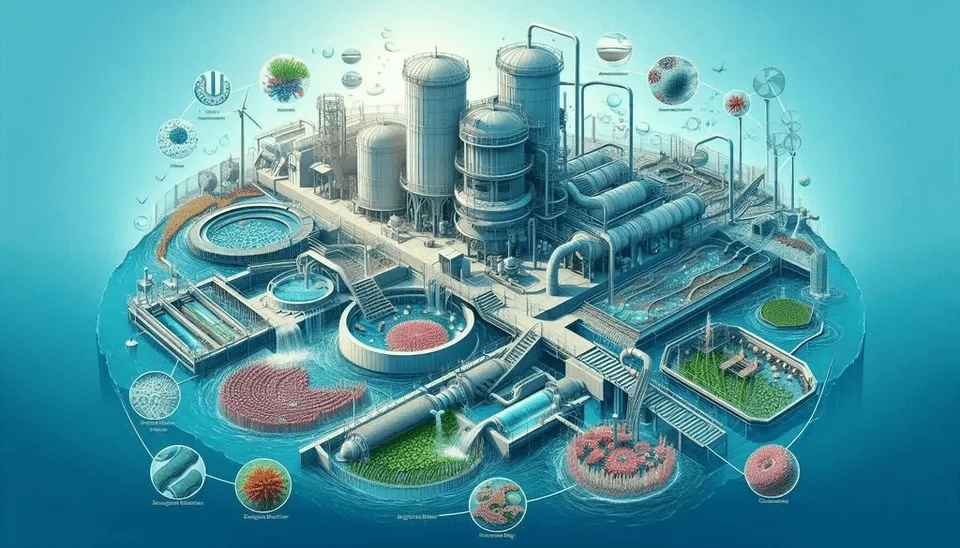
Wastewater generation is constantly increasing as a result of population growth, rising living standards, and economic growth. Annual sewage production is 380 billion cubic meters, and it is predicted to reach over 570 billion cubic meters by 2050. A significant percentage of wastewater is directly discharged into water bodies without treatment, which can cause serious damage to the ecosystem. Whereas, with proper treatment, wastewater can be reused or safely returned to the water cycle (European Investment Bank, 2022).
Conventional wastewater treatment consists of three stages referred to as primary, secondary, and tertiary. In Primary Wastewater Treatment, physical processes such as screening and sedimentation remove floating and settle able solids. Secondary treatment is the biological stage of wastewater treatment. In this process, microorganisms are used to decompose organic compounds and transform them into less harmful end products, such as carbon dioxide and water. Biological treatment of wastewater can eliminate up to 85% of Biological Oxygen Demand (BOD) and suspended solids. Tertiary wastewater treatment is the advanced stage of this procedure if further contaminants need to be removed (Kesari et al., 2021).
In this article, we will review the process of biological treatment. Then we will explain two types of this technique, known as suspended growth and attached growth. Both of these techniques are widely used in wastewater treatment. Biological treatment is commonly categorized as aerobic and anaerobic. Different methods have been developed for each of these two. We will discuss the principles of aerobic and anaerobic treatment and introduce several methods for both of them. Finally, we will make a comparison between aerobic and anaerobic biological treatments of wastewater.
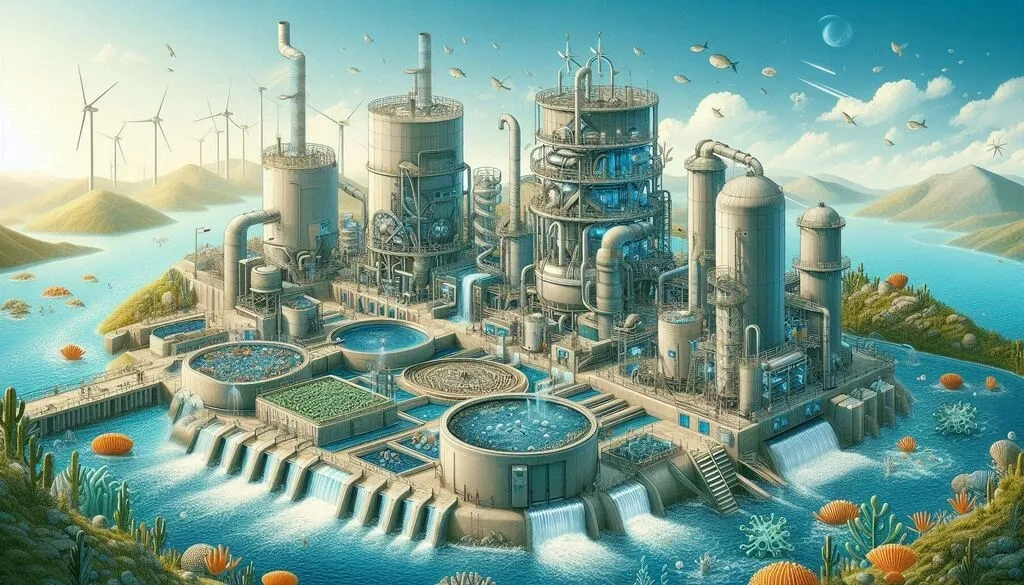
1. An Overview of Biological Treatment of Wastewater
In the biological treatment of wastewater, the microbial community has a vital role in the degradation of contaminants. This process, also referred to as 'biodegradation', is carried out by a variety of microorganisms such as Bacteria in Wastewater Treatment, Fungi, Microalgae for Wastewater Treatment, and Protozoa. Additionally, the combination of Microalgae and Bacteria is being explored for Sustainable Treatment Processes. Compared to physical and chemical processes, biological treatment usually costs less and imposes less damage on the environment. Production of secondary pollutants, a great concern in sewage treatment, is very low or nearly zero in biological treatment (Dadrasnia et al., 2017).
Several purposes are pursued in biological treatment (Metcalf & Eddy, 2014):
Oxidation of organic compounds and transforming them into less hazardous matters
Suspended solids can be removed by getting stuck in flocs or by being a part of a biofilm
Microorganisms use nutrients (e.g., nitrogen and phosphorus) to reproduce themselves, which can result in the removal of these nutrients.
This process has been used to remove some specific pollutants in wastewater, such as trace organic chemicals
Based on the type of cellular respiration, microorganisms can oxidize organic matter in two conditions: aerobic and anaerobic. Each of these two conditions is explained later. There is another classification of biological treatment in which microbes can be attached to a medium or can be suspended in the wastewater. These two modes, known as attached growth and suspended growth, are the subject of the next section of this article
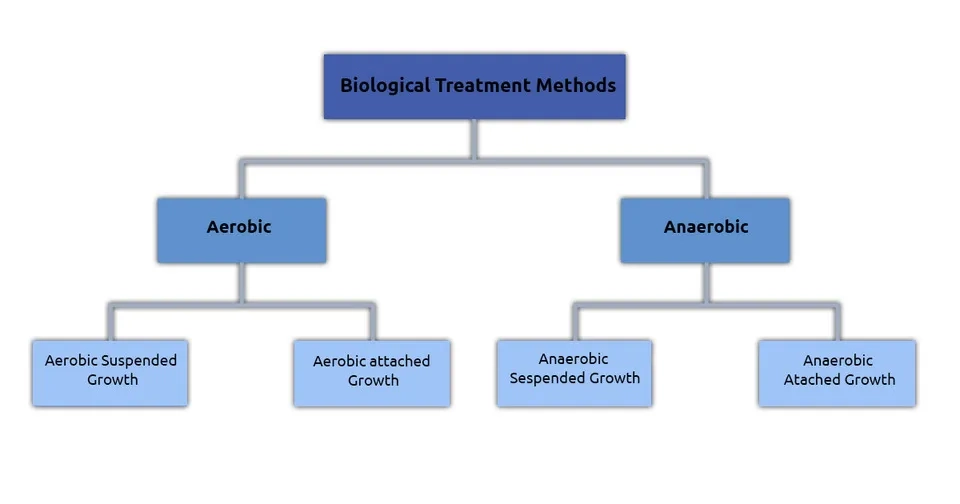
2. Suspended Growth vs. Attached Growth
In the attached growth process, stone or plastic media is used as a fixed bed for microorganisms to grow and form a biofilm on the surface of the media. When sewage comes into contact with the biofilm, microbes degrade organic substances and remove them from the wastewater. A trickling filter is an attached growth system used in the biological treatment of wastewater.
On the other hand, in a suspended growth process, microorganisms degrade organic substances in a liquid suspension. Mixing is usually done to increase contact between microbes and organic matter, which results in better pollutant removal. Activated sludge is an aerobic suspended growth system that is widely used in treatment plants (EPA, 2004).
3. Aerobic Biological Treatment of Wastewater
In aerobic treatment, the oxidation of organic matter happens in the presence of oxygen. To obtain energy, microorganisms convert organic substances using oxidation and reduction reactions. In these reactions, organic matter is oxidized by microorganisms, which causes the organic matter to lose electrons. These electrons reach oxygen through electron carriers, and the released energy is used for cell growth. Microorganisms receive this energy as ATP (adenosine triphosphate) (Comeau, 2008).
َAs a result of the aerobic microbial metabolism described above, organic pollutants break down into carbon dioxide and water. This process is used in various technologies in treating municipal and industrial sewage. Some of them are introduced below.
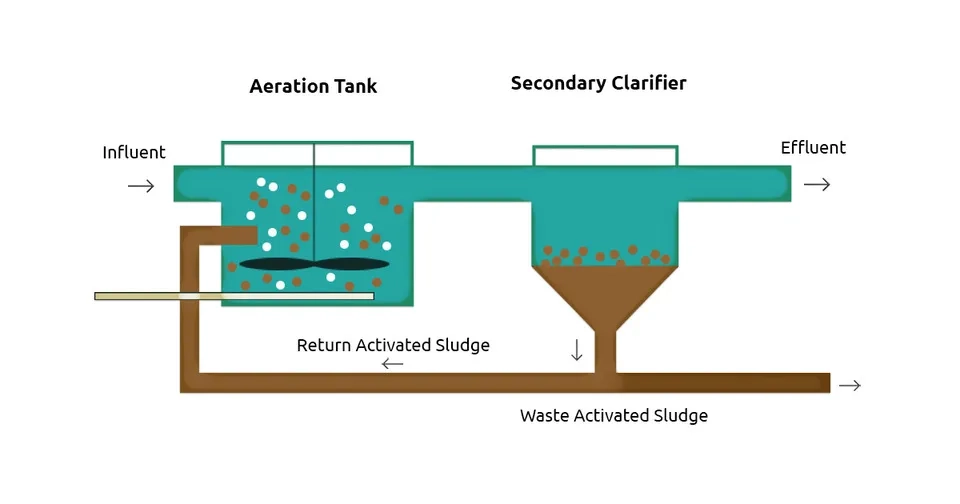
3.2. Trickling Filter
A trickling filter is a fixed film aerobic treatment that consists of a bed filled with media such as rocks or plastic. Microbes attach to the medium and form a slime layer on the surface of it. In trickling filters, wastewater is sprayed on the surface of the packed bed through a rotating distribution system, and air is injected into the system from the bottom of the filter. As wastewater flows down the trickling bed, the slime formed on the media breaks down the organic pollutants in the wastewater. Over time, the thickness of the slime layer increases, and when it reaches a critical thickness, it gets washed off from the media. A fresh layer of biofilm forms again. After the trickling filter, a sedimentation basin is placed to separate the solids from the wastewater. Trickling Filters require an underdrain system for collecting the wastewater and distributing the air through the filter (Daigger and Boltz, 2011).
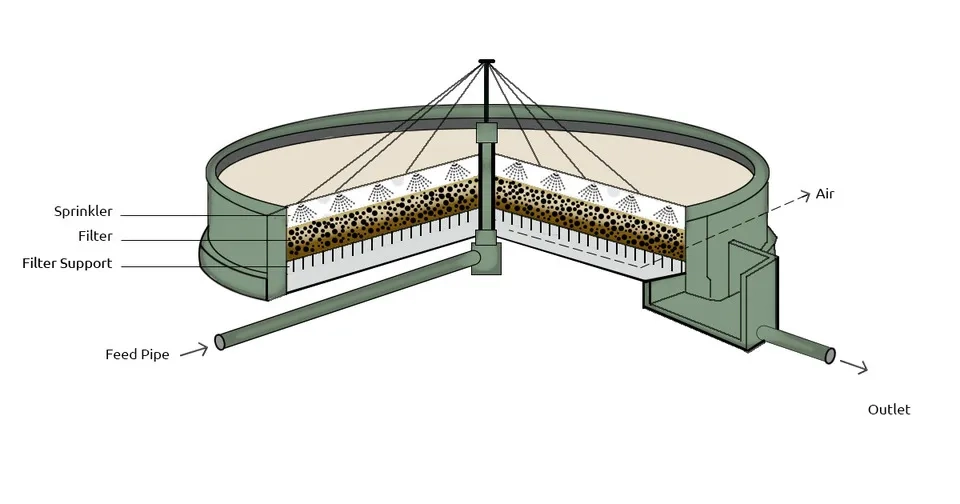
3.3. Membrane Bioreactor (MBR)
Membrane BioReactor (MBR) is a combination of the biological treatment of wastewater by activated sludge along with the physical process of Membrane Filtration.
MBR technology has made a major leap forward thanks to its ability to run at much higher Mixed Liquor Suspended Solids (MLSS) levels and maintain a much longer Sludge Retention Time (SRT) than traditional activated sludge systems. Because membranes handle the solid-liquid separation, MBRs are able to separate the hydraulic retention time (HRT) from the SRT, making the overall system more efficient and compact. This highly concentrated biological environment improves the breakdown of organic pollutants and produces a high-quality effluent that is often clean enough for direct reuse—such as in irrigation or industrial applications—without any additional tertiary treatment. The strong physical barrier provided by the membranes also removes all suspended solids and most pathogens, greatly boosting the hygienic quality of the treated water (Judd, 2017). In addition, MBRs are increasingly combined with advanced nutrient removal steps, including anoxic or anaerobic zones, to enable simultaneous biological nitrogen and phosphorus removal, helping facilities meet strict nutrient discharge standards (Luo et al., 2020).
Microfiltration Technology and Ultrafiltration Technology are used in MBR to separate the solids from the wastewater and recycle the biomass to the reactor. In fact, membranes are used instead of secondary clarifiers to remove solids from the effluent. Membrane bioreactors can be submerged or external. In submerged MBR, the membrane is located inside the biological reactor, while in external MBR the membrane filtration takes place outside of the reactor (Abdelkader, 2007).
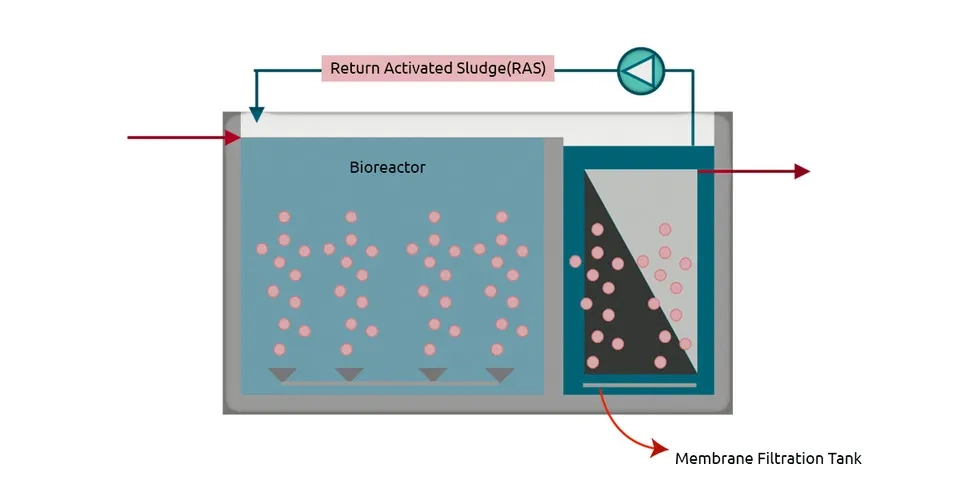
3.4. Sequence Batch Reactor (SBR)
Sequence Batch Reactor (SBR) is a fill-and-draw activated sludge process in which treatment takes place in one basin instead of separate basins. Thus, SBR is suitable for areas with limited available land. There are five steps in one cycle of the SBR process: Fill, react, settle, draw, and idle. At first, the basin gets filled with wastewater. In the second step, mixing and aeration are required for the biological degradation of organic compounds. Then, aeration and mixing are stopped and the basin works as a secondary clarifier. In the fourth step, treated wastewater is discharged. The time between drawing and filling the basin again is called ‘idle’ which is used for sludge wasting (Al-Rekabi et al., 2010).
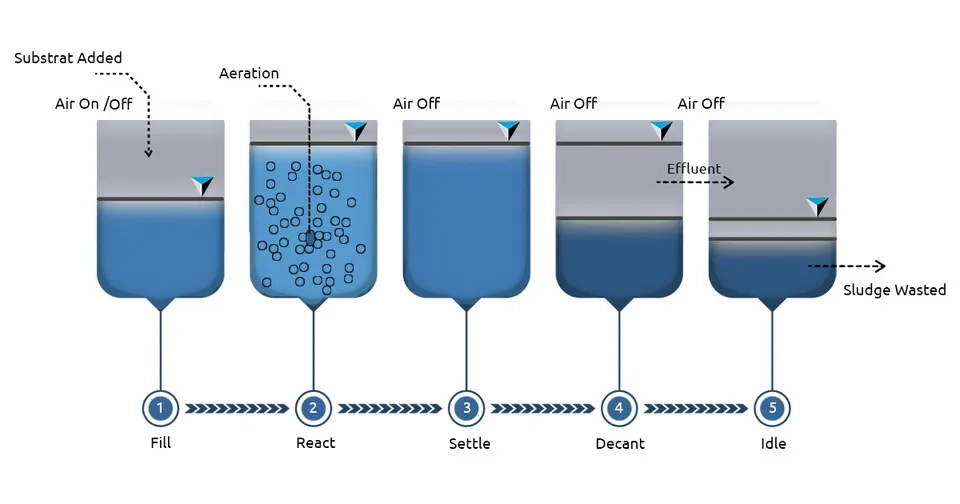
3.5. Rotating Biological Contactor (RBC)
A Rotating Biological Contactor (RBC) is an attached growth system used in treating wastewater on a small municipal or industrial scale. In this method, circular rotating discs are closely put together. These discs are mainly made of plastic materials, and they rotate at a constant speed. Microorganisms form a biofilm on the surface of the discs that are half drowned in wastewater. The rest of the disc is in contact with the atmosphere, which allows microorganisms to receive oxygen. As the discs rotate, microorganisms degrade organic pollutants. A secondary clarifier is placed after the RBC to separate the solids (Waqas et al., 2023).
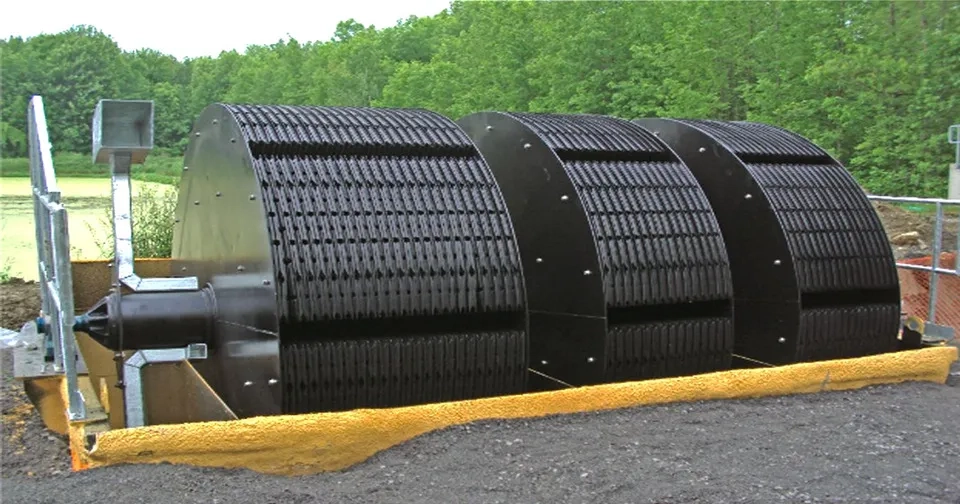
4. Anaerobic Biological Treatment of Wastewater
Anaerobic oxidation of organic matter, unlike aerobic treatment, takes place in the absence of oxygen. Therefore, the electron acceptor and donor are both organic matter. The final product of anaerobic treatment is biogas, and two-thirds of the produced biogas is methane (Meegoda et al., 2018).
Methane is a valuable source of energy, which gives anaerobic treatment an advantage. Numerous anaerobic methods were developed over the years, and some of them are listed below.
4.1. Upflow Anaerobic Sludge Blanket (UASB)
Upflow Anaerobic Sludge Blanket (UASB) is a promising method for treating sewage. It is largely used in industries for high Chemical Oxygen Demand (COD) reduction. In UASB reactors, wastewater flows upward through a layer of sludge with a high microbial population which results in the decomposition of pollutants and the production of biogas. There are three phases in the reactor: gas, liquid, and solids. A separator is placed at the top of the reactor to separate these phases from each other (Nnaji, 2013).
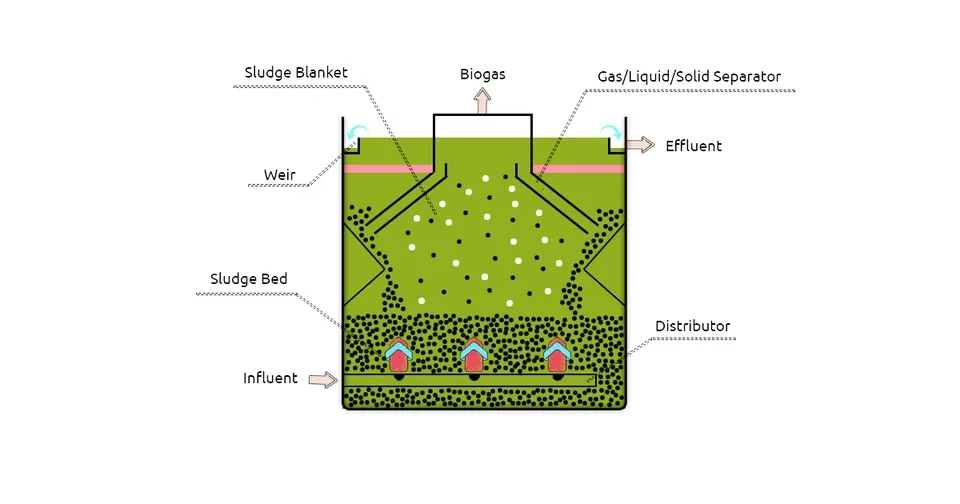
4.2. Anaerobic Fluidized Bed Reactor (AFBR)
Anaerobic Fluidized Bed Reactor(AFBR) is an attached growth method in which the media (e.g., small sand and activated carbon) is suspended in the reactor. Because of its fluidized stage, the media provide a higher specific surface that results in better removal of contamination (Rajeshwari et al., 2000).
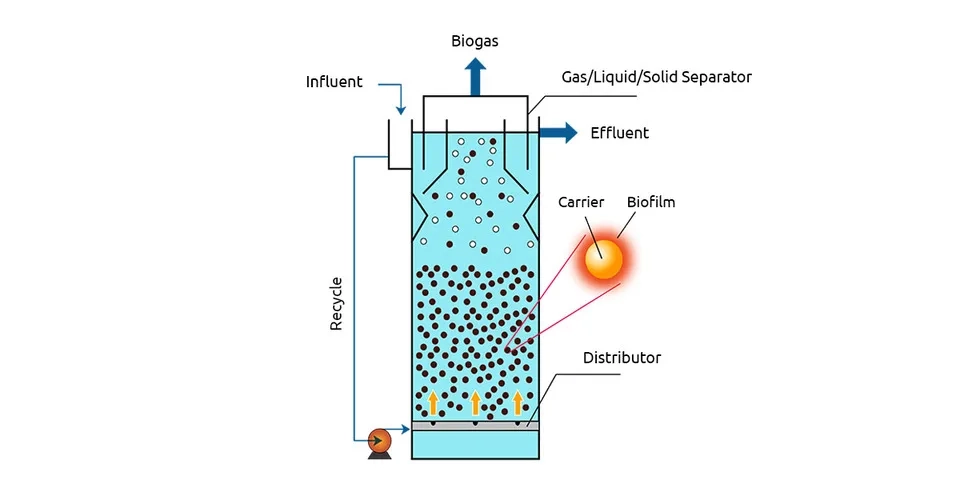
4.3. Anaerobic Baffled Reactor (ABR)
Anaerobic Baffled Reactor (ABR) consists of a tank in which several chambers have been created by placing baffles. These reactors can resist hydraulic and organic variable loads. Wastewater flows on top and below these baffles which results in the decomposition of organic matter and production of biogas. The main advantage of ABR is separating two phases of acid and methane production, which increases microbial activity in the reactor (Barber and Stuckey, 1999).
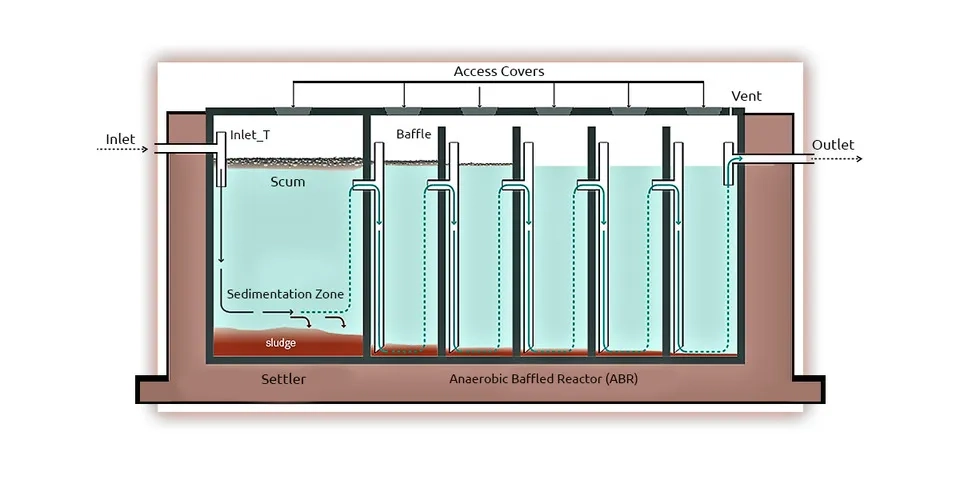
4.4. Anaerobic Contact Process
This process has an anaerobic unit where wastewater is mixed. A settling tank is placed next to this unit to separate anaerobic sludge from wastewater. This sludge is recycled into the anaerobic tank, which enhances microbial contact with raw wastewater. Since gas can interrupt the settlement of solids, a degassifier is placed before the settling tank (Hassan et al., 2013).
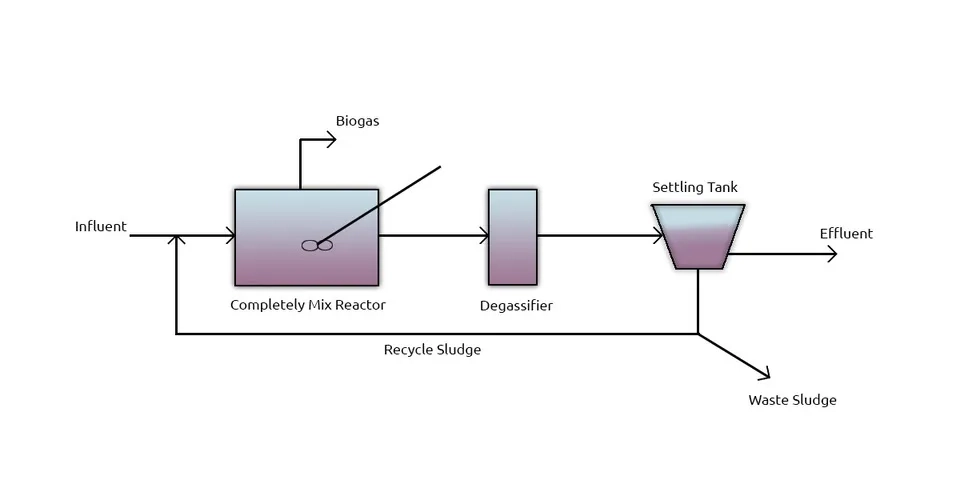
5. A Comparison Between Aerobic and Anaerobic Treatment
The following table compares the aerobic and anaerobic biological treatment of wastewater in various aspects such as waste production, energy consumption, and effluent quality (Anijofor et al., 2017):
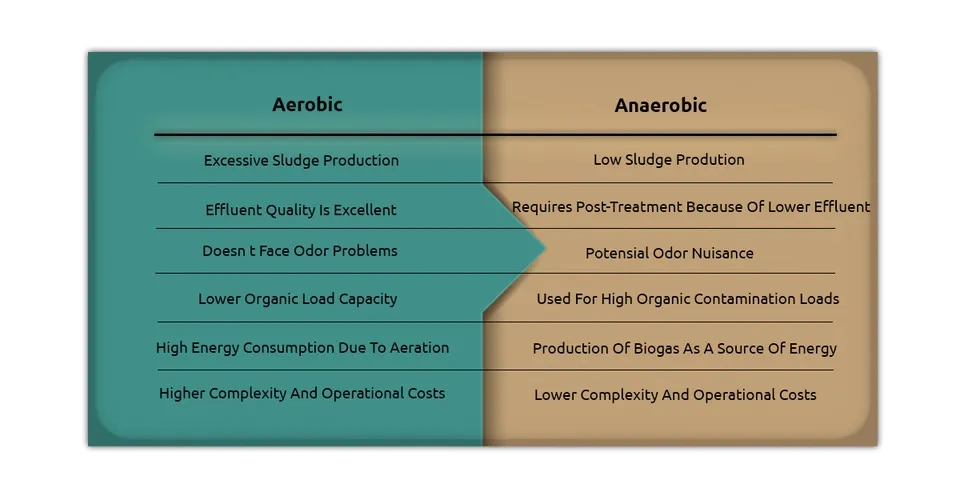
6. Conclusion
Increased sewage production and the lack of freshwater recourses in recent decades, call for more attention in wastewater management. Biological treatment of wastewater has been a prominent method for over a century and it is still the main part of wastewater treatment plants. Biological methods are classified in several ways. They can be divided into aerobic and anaerobic methods. The choice of method depends on many factors, as each method has advantages and disadvantages. Aerobic treatment offers better effluent quality, while anaerobic treatment is more efficient for higher COD loads. Biogas production is another advantage of anaerobic treatment since it can be a source of energy. Activated sludge and UASB reactors are two common systems in aerobic and anaerobic processes, respectively.
